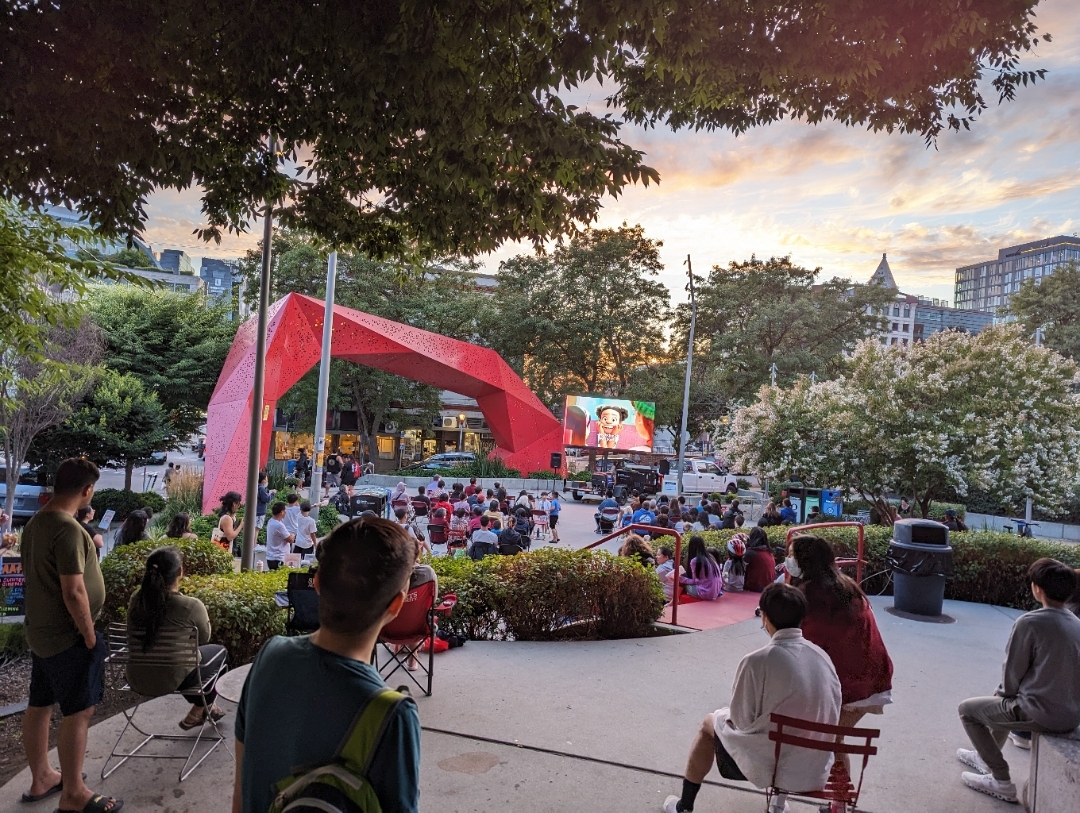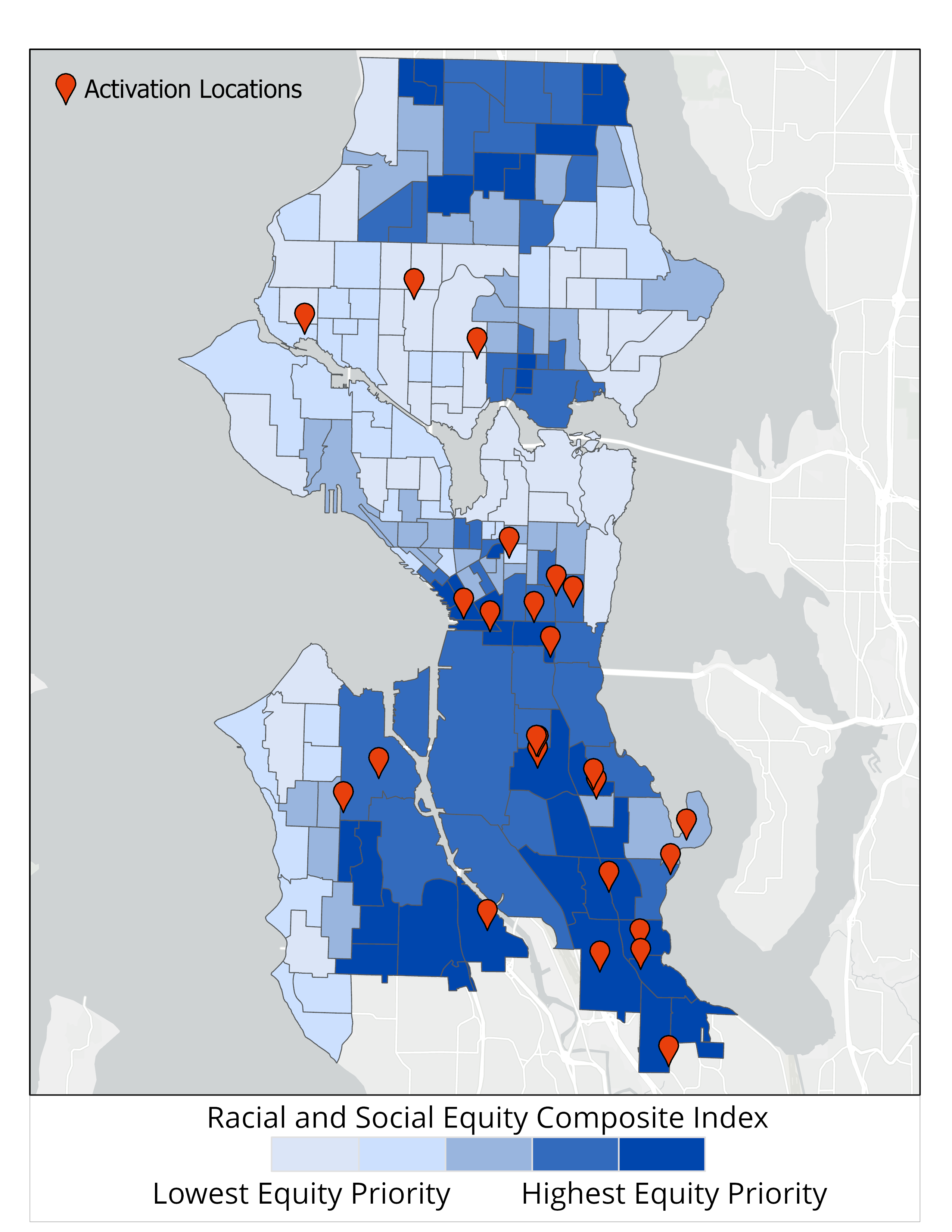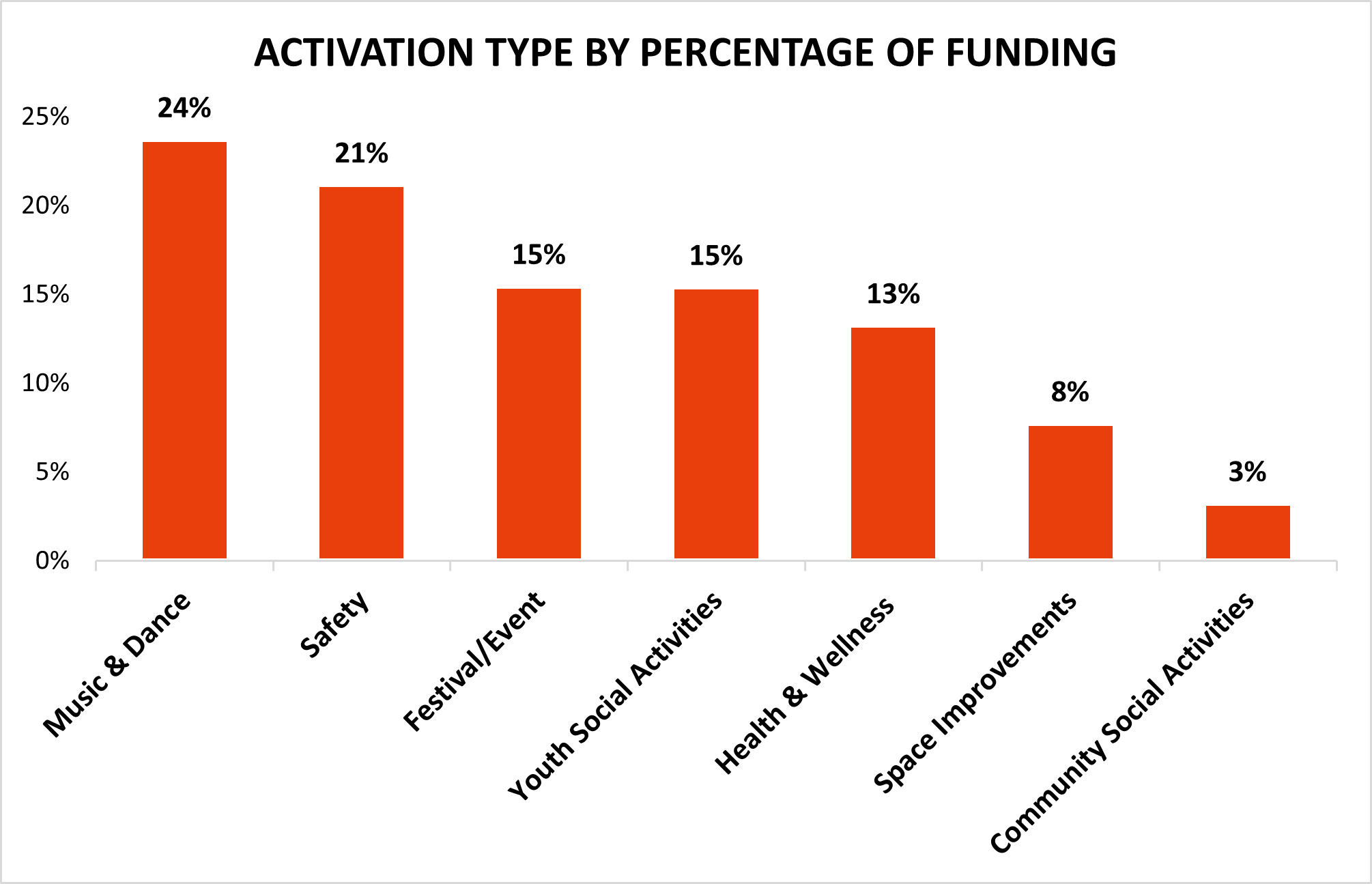 A crowd watching a movie at Hing Hay Park.
A crowd watching a movie at Hing Hay Park. As Seattle continues to recover from the impacts of the COVID-19 pandemic, we’re taking a look back on how the city responded to the public health emergency and how those strategies are impacting our communities today.
Governor Inslee’s Stay Home, Stay Healthy order in 2020 paused most in-person recreation programs as a measure to help contain the spread of the deadly virus. While this drastic step was important to reduce the spread of the pandemic, it also meant that many communities, especially low-income and BIPOC communities, had less access to recreation.
As it became safer for people to gather in-person, the City of Seattle invested federal funding from the American Rescue Plan Act to activate our public parks and make them safe and inviting for everyone’s use. In 2022, Seattle Parks and Recreation partnered with 30 community groups to host 37 activation events and interventions. These activities served a total of about 78,000 attendees.
Activations were spread across the city, with an emphasis on parks located in historically underserved neighborhoods. Out of the 78,000 logged participants across these activations, 98% of them were attending events that were held in areas with the first or second highest equity priority level, according to Seattle’s Race and Social Equity Index.

Organizations were selected through a competitive Request for Proposals process, with grant criteria focused on serving communities and neighborhoods impacted by racial disparities in health outcomes and access to recreation. With a goal of responding to a variety of community needs coming out of the pandemic, activations were spread across seven different categories.

Music and Dance Activations
Live music was one of the first activities that was paused during COVID-19. Seven activations in 2022 brought free music and dance back to Seattle neighborhoods.
This included multiple series of free dance workshops. A couple of series taught African dance and drums, such as the “Alafia: Sacred Drum and Dance” classes at Judkins Park and the “Dance is Where We Heal” sessions hosted at Youngstown Cultural Art Center.
There were also stand-alone events and festivals, including the fully accessible Rock the Park music festival hosted at Jefferson Park in August 2022 featuring local Seattle musicians of all abilities.

Festivals and Events
Funding supported a wide variety of community-led events and festivals. For example, the Vera Project and Northwest Film Forum used funding to host BAZZOOKAFEST in August 2022 at Jefferson Park. This was a celebration for all LGBTQIA+ members of Seattle’s black and brown communities, with a ball employing drag artists, dance performers, and DJs of color to perform live. The event also featured a market for black-owned businesses.
Experience Education used funding to host “Future Ancient” at Hing Hay Park, an event featuring local artists and cultural workers sharing how they center their cultural futures and collective liberation through their work.
Funding also supported long-running and familiar Parks programs, including the popular Summer Outdoor Movie Nights and community-organized Capitol Hill Garage Sale. All together, these different festivals and events drew about 31,000 visitors.

Youth Social Activities
COVID-19 shutdowns took a huge toll on youth, who lost out on opportunities to socialize and exercise through school and experienced increased stress and mental health challenges. This is why funding supported eight programs that focused on creating fun, healthy activities for young people.
Funding supported community-based organizations including the Hi-Tee Little League Golf Program, which focuses on introducing African American youth to golf, and Inspired Child, which provides swimming lessons at Rainier Beach Community Center. Activities also included the “Write to Breathe Theater Camp,” which taught storytelling and poetry, and free haircuts, food, music, and entertainment hosted by Fathers and Sons Together (FAST).
Health and Wellness
Seven activations focused on culturally-relevant health and wellness activities for their communities. For example, the Lao Women Association of Washington hosted dance and aerobics classes, in addition to hosting their annual picnic at Seward Park. Free Flo Fit hosted their annual Fit Melanin Summer event featuring black and brown vendors and fun, high-energy workouts and performers.
While these events focused on exercise and physical fitness, others focused on overall health and wellness. The Muslimah’s Against Abuse Center, for example, hosts a bi-weekly brunch for mothers to discuss topics such as postpartum depression and maternal health abuse, with a goal of creating a space for new moms to be themselves and relax.
Community Social Activities
Funding also supported several community activities hosted through Golden Bricks Events, an outdoor focused, BIPOC-centered event production company. Events included Refuge Day, a free event where people can learn outdoor recreation skills, have fun, and build connections with others.
Safety Activations

One important intervention to bring Seattleites back out to enjoy public parks was to make safety improvements so that spaces would feel welcoming for all park users.
This work included installation of more lighting at Cal Anderson Park to address safety concerns. Funding also supported an additional park concierge at Hing Hay Park and a third busker at Pioner Square Summer Hours. These additional resources helped bring more foot traffic to parks that saw a significant drop in use during the pandemic.
Space Improvements
Finally, eight percent of funding was used to purchase and install additional outdoor furniture at Seattle Parks, including umbrellas, chairs, and tables at Cal Anderson Park.
Thank You to Community Partners
Many of the events and programs supported by COVID-19 relief funding are long-standing programs that were put on hold due to the pandemic. Others are brand new activities that are now continuing thanks to these one-time investments.
An important part of Seattle’s COVID-19 recovery strategy is partnering with and building capacity in local community-based organizations. By working with local leaders and community groups, these programs were able to reach and serve many of Seattle’s diverse communities.
Thank you to the organizations and individuals that provided culturally responsive programs and activities in 2022!
- Adefua Cultural Workshop
- Asé Theatre (formerly Griot Girlz)
- Barbara Jean Brown Foundation
- Beacon Arts
- BeautyBoiz
- Blessed Hearts Fitness
- Center for Linguistic & Cultural Democracy
- Experience Education
- Fathers and Sons Together (FAST)
- Franchesska Berry
- Free Flo Fit
- The Future Ancient
- Golden Bricks, LLC
- Hi-Tee Jr Little League Golf Program
- I Am Diva Girl
- Inspired Child
- Kathya Alexander
- Lao Women Association
- Maria Rico Dance
- Muslimahs Against Abuse Center
- Needs of the Community Society
- Northwest Film Forum
- Orquesta Northwest
- Redefine Magazine
- The Royal House of Noir
- The Vera Project
What’s Next?
Seattle Parks and Recreation has finished granting pandemic relief funding for community recovery events and activations. However, they continue to offer year-round programming and events, including many of the events, classes, and services listed above.
Follow @SeattleParks on Twitter, @SeattleParksandRecreation on Facebook, and @Seattleparksandrec on Instagram, and check out the Parkways Blog to stay up to date on events in your neighborhood.
Learn more about the Seattle Rescue Plan, Seattle’s strategy to invest federal relief funding to help our community equitably recover from the pandemic.